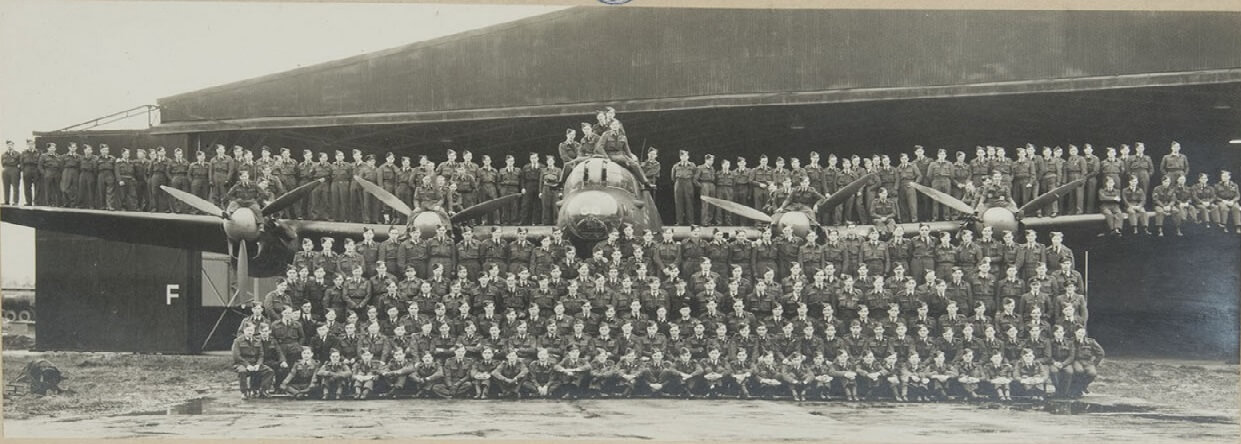
Sergeant Keith Russell Baker, the story of a ‘Tail-End Charlie’ who died in Nunspeet, the Netherlands, in 1944 and how the town is keeping his memory alive by Alison Bailey, with thanks to Sue Cottrell and Wessel Scheer
Sgt Keith R Baker is a name on the Chesham Bois War Memorial. He is one of the 17 men and one woman from the parish who died during WWII and whose names are read out every year at our Rememberance Day Service. He is one of four aircrew who were killed when their Lancaster bomber crashed 13 June 1944 and is buried in the Dutch municipality of Nunspeet, an agricultural area, 54 miles from Amsterdam. Today all seven members of the aircrew are commemorated in a new memorial close to the crash site thanks to the hard work of local resident, Wessel Scheer. A pilot with a passion for WWII history, Wessel decided to research the story of the plane crash during the first coronavirus lockdown when he found himself unexpectedly grounded. Thanks to his email enquiry to Amersham Museum, we now know a little of Keith Baker’s story and what happened to the aircrew of the Avro Lancaster DS818 / JI-Q of the 514 Squadron.

The pilot and crew referred to the plane as Queenie after its call sign “Q for Queenie”. This is also how it was referred to in contemporary newspaper articles, however, after the crash the name Maggie was found engraved on the engine shield which was noted in the police report. Maggie has been used as the name of Avro Lancaster DS818 / JI-Q since then.
13 June 1944
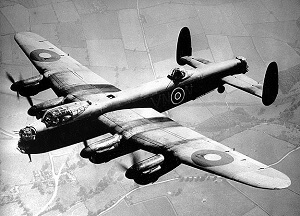
In a clear sky, in the early hours of the morning of 13 June 1944 Maggie was shot down over Nunspeet, then a small rural village. The previous day the Lancaster had taken off from RAF Bomber Command Waterbeach in Cambridgeshire and had successfully bombed German oil installations in Gelsenkirchen. Whilst limping home, damaged by flak, Maggie was attacked by a German nightfighter and burst into flames. Three of the crew parachuted from the stricken Lancaster and survived.
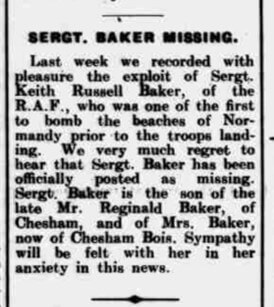
21-year-old Krijn Polinder witnessed the plane plummeting towards him around 2am. He was in hiding in an underground hut on his family farm to avoid being sent to the Nazi labour camps. Completely out of control, the burning plane just avoided the thatched roof of the farmhouse and crashed into a neighbouring rye field, killing the three crewmen trapped in the fuselage, Flight Sgt Gordon ‘Jock’ Lewis, Sgt William Steger and Sgt George Brown, who weren’t identified until after the war. The tailpiece, which was not consumed by fire, had broken away. It fell on the oat field of a neighbouring farm, killing the rear gunner, 20-year-old Sgt Keith Baker from Chesham Bois.
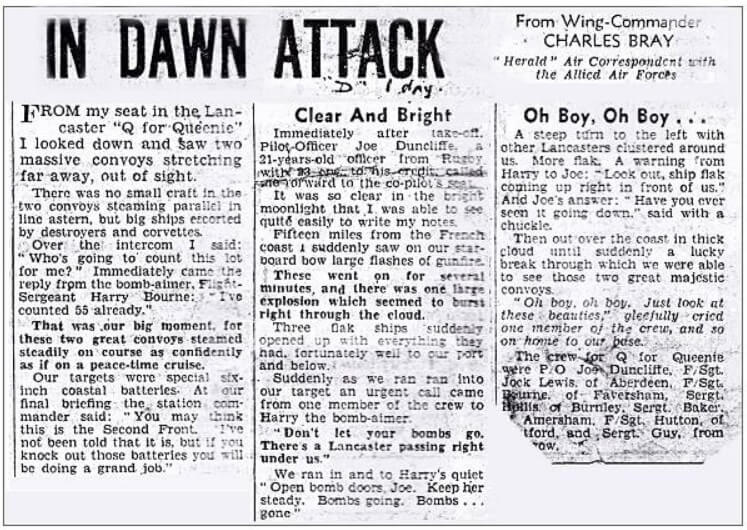
Tail End Charlie

At 18, Keith Baker volunteered for the RAF. At 19 he had one of the war’s most dangerous jobs – a gunner on a Lancaster bomber. His chances of survival were slim – half of all Bomber Command’s aircrews perished. Sgt Baker was a rear gunner, a “Tail End Charlie”, who, isolated from the rest of the crew during operations, was confined in his Perspex turret right at the back of the plane. Unable to move for the duration of the flight, his head would have touched the top of the turret and his shoulders brushed the sides. There was only enough room in front to grasp the triggers of the four Browning machine guns. As the turret was in the unheated section of the fuselage, temperatures could go as low as -40C and he would have worn an electrically heated flight suit. Even this did not stop his breath freezing in icicles. His job was to scan the black skies for a glimpse of enemy aircraft, to advise his pilot to take evasive action and when required, to defend the aircraft.
Click on this link for a virtual tour of a Lancaster Bomber
In Tony Rennell’s 2012 article for the Mailonline tail gunner Bob Pierson described the job as follows:
“’You see something. Your heart jumps. But you can’t just blaze away. If you fire, the tracer will give your position away to the enemy for sure. And, anyway, you might hit another Lancaster. Plenty of planes were knocked out by someone on their own side panicking. So you wait. And it gets closer, until you can make out a head and shoulders in the cockpit. Is he going to keep coming? Is he going to start firing?’
‘Sometimes he peels away out of sight, and that’s the worst moment of all. All you can do is pray that he hasn’t dived below you and is coming back underneath with his guns blazing. The horror was waiting and not knowing, wondering if you were about to die.’
‘If an attack came, the skipper would throw the Lanc into a steep dive. The wings go down, the tail comes hurtling up. You go up, too, and then you plunge back down as the skipper pulls back on the stick and the plane climbs steeply in the opposite direction. The G-force clamps on your head like a ton of concrete. Your chin is pressed hard into your chest. And all the time you are still trying to fire at the enemy fighter on your tail.’”
If the crew had to abandon the aircraft the rear gunner was in the most difficult position. He had to open a small sliding door and move backwards out of the turret before he could put on his parachute.
514 Squadron
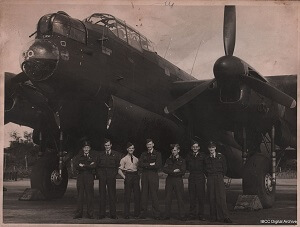
In February 1944 Sgt Baker was posted to his last operational unit, 514 Squadron from 1678 Conversion Flight, a training unit to instruct airmen trained on medium bombers to operate Avro Lancasters, the heavy bombers used by 514 Squadron. Both units were based at RAF Waterbeach, seven miles north of Cambridge. This was a relatively modern airfield having been completed shortly before war was declared. The station had red brick barracks instead of the usual Nissen Huts with hot and cold running water which was considered a great luxury.

Operation Record Books show that Sgt Baker flew with New Zealand Pilot Officer Bernard William Windsor 22 April and 19 May. He was not with P/O Windsor on 21 May when his Lancaster bomber DS781 JI-R was shot down over the North Sea and all the crew killed in action. He now joined Pilot Officer Derek Anthony “Joe” Duncliffe and his crew in Lancaster bomber DS818, JI-Q, Maggie. P/O Duncliffe from Rugby was only 21 but already a veteran with around 24 operations. 6 June 1944 the D-Day Landings started, and Bomber Command had a vital role attacking artillery batteries to support the troops on the ground and bombing railways to prevent reinforcements reaching Normandy. P/O Duncliffe’s Maggie, with Sgt Baker as the tail gunner flew four missions over France from 6 to 11 June.
12 June 1944
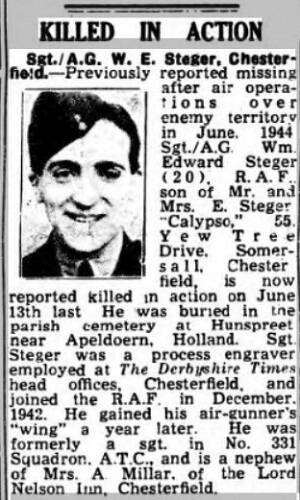
On the night of 12 June, the target was in Germany. As far as we know, this was Sgt Baker’s seventh operation. Estimates for the life expectancy of a WWII Lancaster rear gunner vary but are never high at around five sorties. At 23.11 hours, 17 Lancasters left RAF Waterbeach but four hours and 40 minutes later only 15 returned. They were part of a bombing stream of 286 Lancasters and 17 Mosquitos whose objective was to attack the Nordstein (Gelsenberg AG) oil refinery at Gelsenkirchen in Germany. The raid was successful. Over 1,500 bombs hit their target and disrupted oil production for several weeks with the loss of around 1000 litres of precious aviation fuel every day. But there were heavy losses on both sides. 270 were killed on the ground and 108 airmen and 17 Lancasters were lost.
When Maggie reached the target area the crew saw enormous fires and large columns of smoke. There were searchlights combing the sky and intense anti-aircraft fire (flak). F/S Harry Bourne, the bomb aimer, released the bombs and as P/O Duncliffe turned for home the aircraft should have felt much lighter. However, at some point Maggie was damaged by flak which would have resonated through the plane as huge, hollow bangs.
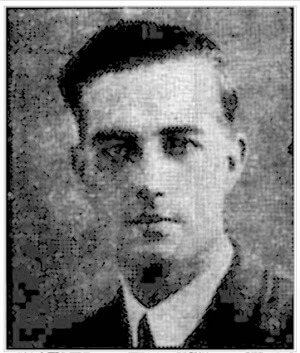
They now had to limp back at lower altitude and lower speed. This made the Lancaster an easy prey for the German night fighter, Lieutenant Ernst-Ewald Hittler, who spotted it flying over farmland in central Holland and attacked. At 01.30-02.00 hours (Dutch time), Maggie crashed to the north-east of the village of Nunspeet. Three of the crew, Flight Sgt Lewis (23) from Aberdeen, the navigator Sgt Steger (20) from Derbyshire, the mid upper air gunner and Sgt Brown (31) from Kinnell in Angus, the wireless operator/air gunner came down in the burning fuselage and could not be saved.
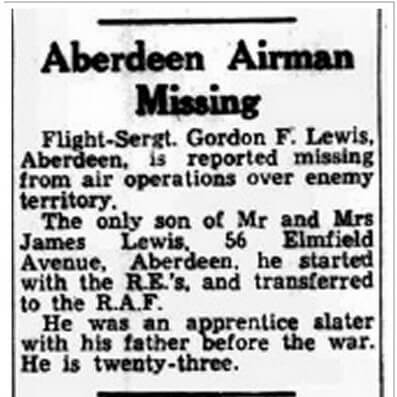
The morning after the crash children on the way to school found the dead body of the seventh crew member, Sgt Keith Baker. The tail of the plane with the rear gun turret had broken away before the crash and Sgt Baker had not been able to operate his parachute. He probably died on impact when his gun turret landed in an oat field on Nagelhout farm on Oosteinderweg 70, some distance from the rest of the wreckage. Today there is a housing development, Heemskerklaan, on the site of this field.
The survivors
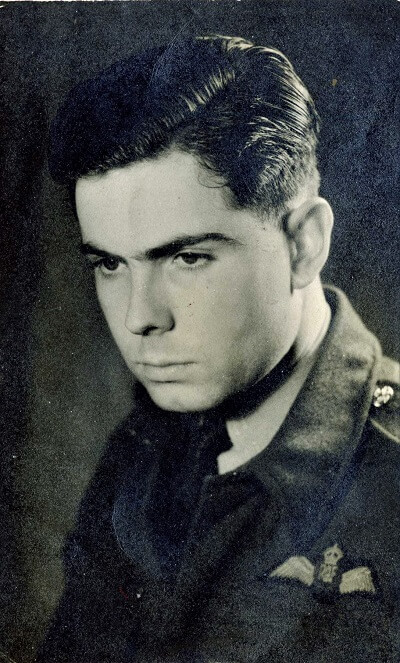
Three had parachuted clear. P/O Duncliffe evaded capture and was hidden by the Dutch Resistance until the Netherlands were liberated. Sgt Peter Cooper (24) from London broke his leg when he landed in a tree. He was arrested by a German patrol and taken to hospital in Amsterdam. F/S Harry Bourne (26) from Faversham was rescued but insisted on returning to the plane and was also arrested. They both survived as prisoners of war in Poland including a 2-week Death March as the war was ending between Stalag VII in Bankau and Stalag IIIA Luckenwalde. Many suffered from hypothermia and frostbite. Both returned home safely in 1945.
The monument
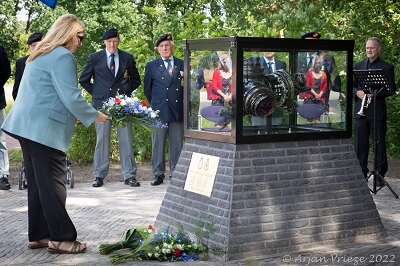
78 years later, the now thriving municipality of Nunspeet honoured all the crew of the Lancaster by holding a ceremony to unveil a new monument which I had the privilege to attend, representing the family of our local boy, Keith Baker, as they were unable to be there.

Wessel Scheer had the idea of creating a permanent memorial to the crash after he learned that a significant part of the wreckage still existed. The propeller hub had been discovered in 1994 at the crash site by investigator Gerrit De Ruiter with his metal detector and it was still in his shed. Not only did Wessel persuade Gerry to donate the hub but he also convinced him to join his working group!
In the 90s Gerry had travelled to Rugby to meet Derek Duncliffe and following his death, was still in touch with his family. Wessel contacted Amersham Museum for information on Keith Baker and similar enquiries were made about the other airmen. Gradually the story of the Lancaster’s crew was pieced together.
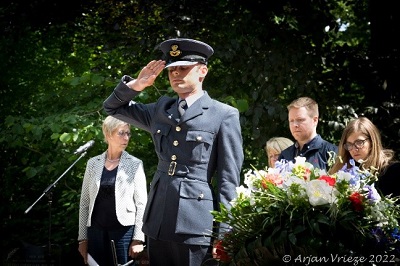
Another significant member of the team was Gerrit Polinder, Krijn Polinder’s nephew who still runs the family farm. The Polinders had sold the field where the Lancaster crashed to a poultry processing plant, but when this company recently went into liquidation the land came into the ownership of the municipality for industrial development. Gerrit believed this was an opportunity to create a memorial on the land which he had always hoped to do. Wessel’s working group also included local historian Dick Baas, Harwin Prins, the monument’s designer and Cees Veldman from the local council. Crucially the idea was supported by the Town Council and in a short space of time an easily accessible location was agreed close to the crash site, and funding was secured.
13 June 2022
At 2pm Monday 13 June 2022, the ceremony was held in front of a large crowd with a Guard of Honour of veterans from The Netherlands and Britain. The newly appointed Mayor of Nunspeet and Nicky Brayn, P/O Duncliffe’s granddaughter then unveiled the monument with a brass band, speeches and even a fly past.
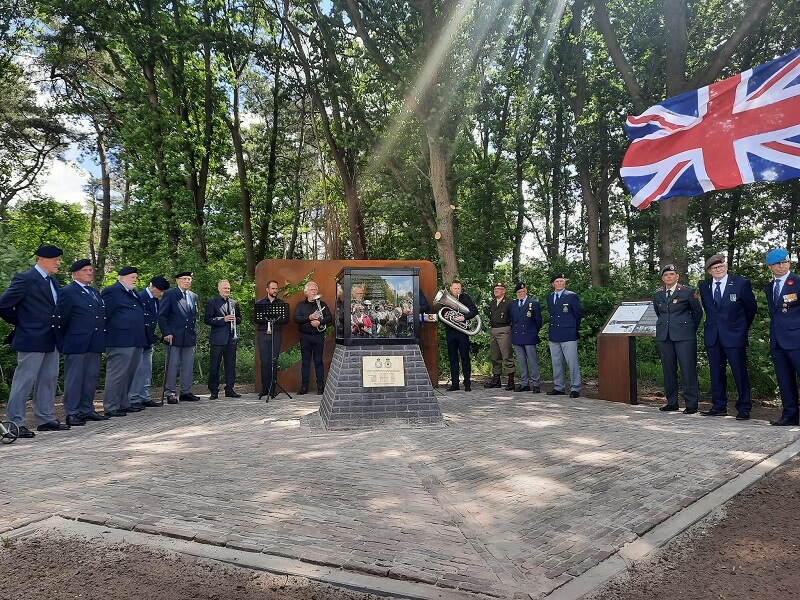
The monument has the propeller hub positioned on a brick plinth at its centre. The hub points north-west towards the airbase at Waterbeach. At the back is a Corten Steel panel with milled out propeller blades so that when you stand in front of the monument the hub appears to be connected to the blades. The pentagon shape of the contrasting brick pavement represents the five years of war. There is also an information board and a plaque commemorating the names of the seven airmen.

A short service of commemoration was later held at the Nunspeet-Oost Cemetery, by the graves of the four aircrew, where the Last Post was played, and Tayah Duncliffe, also a granddaughter of the pilot, gave a heartfelt speech thanking the town on behalf of all the families. Everyone then filed respectively past the graves of the crew members with their framed photographs on display. Earlier Wessel had added a second photograph of Keith Baker with his nephew, Richard Gann, as Richard was unable to attend the ceremony.
Rick Brooks, another researcher, was present, representing the family of Sgt Harry Bourne, one of the survivors of the crash. Rick was able to live stream the entire ceremony to Harry’s stepdaughter, Maggie, as she was unable to attend. However, seven members of the Duncliffe family were at the ceremony including Derek’s son, Phillip and daughter, Barbara. None of them would have been there that day if local people and the Dutch Resistance had not kept Derek Duncliffe safe after he successfully parachuted out of his stricken Lancaster.
Pilot Officer Derek Duncliffe
Derek landed in a clearing, having lost his boots when he bailed out, and was later spotted walking on a forest path by young Wim Mazier, on his way to school. Wim only realised that he wasn’t a dreaded German when he spotted Derek’s stockinged feet. The quick-thinking boy took the airman to an underground hut close-by as he knew that German soldiers would already be in the area searching the crash site. Wim ran home to warn his family, who were members of the Resistance, and soon returned with coffee and sandwiches.
Derek was then hidden in various safe houses around Nunspeet before he was taken to the Hidden Village add link Het verhaal van het Verscholen Dorp | Het Verscholen Dorp (verscholendorpvierhouten.nl) in the neighbouring Soerelse forest. Derek stayed here for three weeks before he was moved on to Apeldoorn where he stayed until it was liberated by Canadian soldiers in April 1945. He then joined them in the fight to free The Netherlands from German occupation.
Het Verscholen Dorp

The Hidden Village was established in 1943 by the Bakkers from Nunspeet to hide their Jewish neighbours with the support of a wealthy lawyer Edouard (De Boem) von Baumhauer from Vierhouten. It grew into an organised camp of nine well-camouflaged huts in four separate areas of the dense pine forest separated by fire breaks. With the support of many local families, at great personal risk to themselves, ‘Opa’ (Grandpa) Bakker and his wife Cornelia, ‘Tante Cor’ provided supplies and transport to keep the camp running. Between 1943 and its discovery in October 1944, it provided refuge for between 80 and 100 people in hiding. These included Jewish families, Allied airmen, and even a Russian and a German deserter.
The atmospheric forest hideout is now a heritage and education centre where three well-hidden and partly underground huts have been rebuilt as they would have been in 1944. Nearby, on one of the forest roads, Tongerenseweg, there is a memorial to the 8 Jewish camp members who were discovered and murdered in October 1944. Amazingly around 80 people fled to safety after realising that the Germans had discovered the camp. The Nunspeet-Oost Cemetery also contains the well-tended graves of resistance fighters who were killed during the war including the grave of Opa Bakker. Tante Cor is buried opposite having lived until 1989. Hundreds of people attended her funeral.
The families back home
Back in England in 1944 the families of the aircrew were desperate for news. 14 June they were sent a telegram by the Air Ministry Casualty Department notifying them that the plane was reported missing “as a result of air operations on the night of 12th/13th June”. Keith Baker’s mother, Edith, received her telegram just two days before her local paper, the Bucks Examiner, published an article celebrating that air-gunner Keith Baker had completed his first year in the RAF in March and “was one of the first to bomb the beaches of Normandy prior to the troops landing”. It when on “he is the son of the late Mr Reginald Baker, well known cycle maker in Chesham in his day, a man of ideas [who] would have been particularly proud of this lad”. A week later, 23 June the same paper had to report that “we very much regret to report that Sergt. Baker has been officially posted as missing. Sympathy will be felt with [Mrs Baker] in this news”.
It is not known when exactly Edith Baker heard confirmation of her son’s death, but it was probably a few weeks later in September as Derek’s fiancé (later his wife) Nancy, received a letter from the Air Ministry dated 14 September 1944 notifying her that a report “regarding certain occupants of the aircraft had been received from the International Red Cross Committee”.
This report “quoting German information, states that Flight Sergeant H. J. Bourne, Sergeant P. G. Cooper, were captured on the 13th June 1944, Sergeant K. R. Baker and three members, whose identity the German Authorities are unable to establish at present, all belonging to the crew of this Lancaster aircraft, lost their lives on this date.
As there were seven members of the crew, it will be appreciated that it is not possible on the above information to state precisely who are the three unidentified members, but it is considered that you would wish to be notified of this report”.
Nancy never gave up hope that her fiancé would return to her, which indeed he did in 1945, but sadly the families of Jock Lewis, William Steger and George Brown also had to wait for news of their fate as it was difficult to identify the bodies in the burnt-out fuselage. F/S Lewis was identified after the war because he was wearing a special watch which only navigators received from the RAF.
Harry Bourne
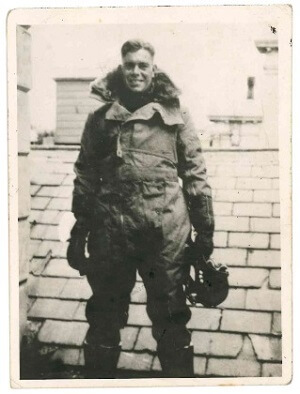
Harry Bourne returned to his hometown of Faversham in Kent after he was liberated from the POW camp. He became a general builder establishing his own business in the town and was known locally as ‘a true gentleman’. He died in 1999. His family said that Harry spoke very little about the war but did tell them that during his time in the POW camp he would use his carpentry skills to repair doors and furniture. For this he would get extra rations which he would share with his fellow prisoners. Harry suffered from frostbite after the Long March and had problems with his hearing caused by the noise inside the Lancaster. He also suffered a recurring nightmare after an incident in the camp. He was caught stealing a carrot and a guard held a gun to his head saying he would be shot for stealing food. The guard shouted “BANG” before walking away laughing.
Peter Geoffrey Cooper
Peter Cooper’s debrief following his liberation (Military Intelligence 9 Report) quotes him saying that in the camp he was “badly fed, thanks to the Red Cross, still alive”. After the war he served at the Army Scaling and Cataloguing Authority (ASCA) in Woolwich and it is believed that he lived in Eltham in South East London, had at least one son and died in 1983.
Nunspeet 2022
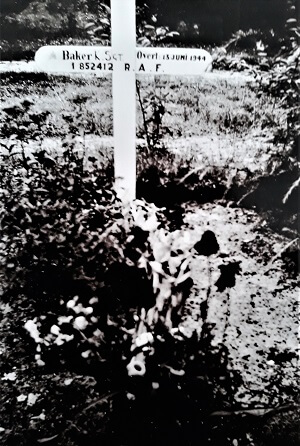
Although many family members were unable to attend the unveiling ceremony in June 2022, they can rest assured that their loved ones are being remembered and honoured today by the generous people of Nunspeet, and that this monument will continue to inform future generations of the extraordinary story of the Avro Lancaster Maggie and its brave crew. On 4 May, Remembrance Day in Holland, services are held all over the country. In Nunspeet the Union Jack and the Flag of the Netherlands, are at half-mast as a sign of mourning from 6pm until sundown and two minutes silence is observed at 8pm. The following day the flags are hoisted again to celebrate Liberation Day. Wreaths of poppies are also laid in the cemetery on Remembrance Sunday each November. About 350-400 people attend the services, which is a lot for such a small town.
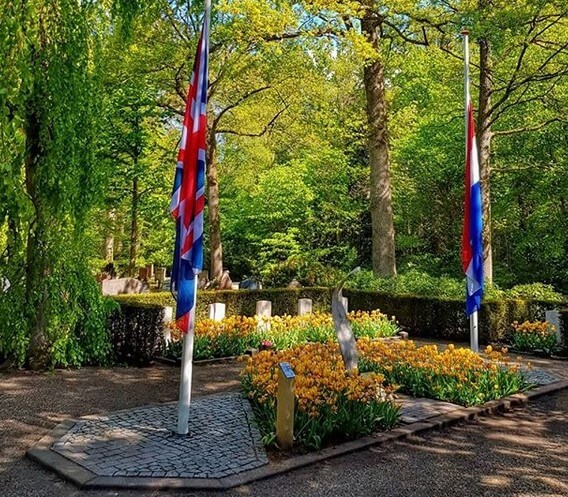

The short life of Keith Baker and his family history
Keith was born 6 March 1924 to Reginald and Edith Baker who lived in Chesham. He had a sister, Pamela, who was two years older. Their father had a successful business in Chesham High Street selling motorbikes, bicycles, and petrol. He was the son of Chesham shoemaker, Obadiah Baker and grandson of the under gamekeeper at Shardeloes, Amersham.
Reginald started work as a bootmaker before getting a job in the cycle shop. He served in German East Africa during WWI where he was invalided out in 1917 with cerebral malaria, rheumatic fever and pleurisy. His 26-year-old brother, Arthur James Baker, was killed in Flanders in 1918 and is commemorated on the Chesham War Memorial. After many months in hospital in South Africa and Scotland Reginald returned to Chesham, took over the cycle business and, in 1920, married Edith in St Mary’s Church.

Edith Constance Pedder was born in Willesden, North London in 1901. Her father, George Henry Pedder was a skilled bricklayer and the family moved regularly with his building jobs between North London, Luton, and Buckinghamshire before settling in Holloway Lane Chesham Bois around the time of WWI. It is believed that George worked as a master bricklayer for the Arts and Crafts architect and builder Harold Kennard and was responsible for much of the fine brickwork detailing on local Kennard buildings. The family house on Holloway Lane, then known as Canton (George also worked in China) and later Mountview, has very distinctive round windows circled with bricks. These round windows are a feature repeated in Kennard buildings in Amersham. George Pedder is listed on the Chesham Bois Roll of Honour as serving his country in WWI he died in Amersham in 1925.
Richard Gann, Keith’s nephew, says that he remembers, when visiting 199 Bois Moor Road, the home of his great-grandmother, Emily Pedder (by then Emily Hearn) that she treasured 2 models of Lancaster bombers that had been made by Keith’s crew members, Harry Bourne and Peter Cooper, when they were PoWs in Germany.
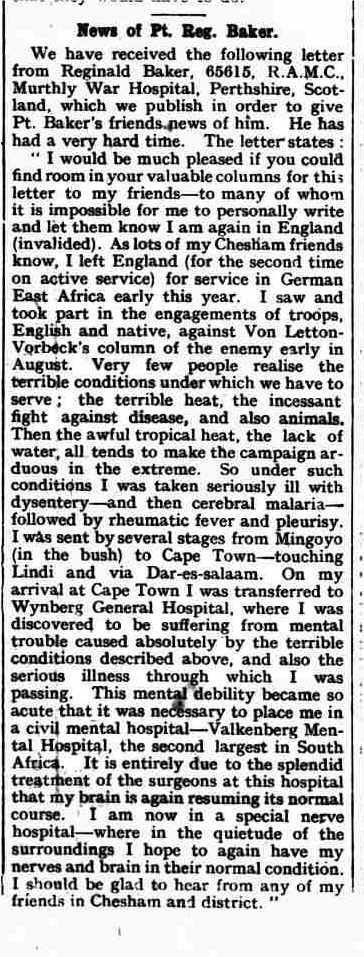
George and Emily Pedder had eight children, Gwendoline, Edith, Reginald, Ernest, John, Eric (who became a policeman) and Stanley who was born at Canton in 1917. Stanley Pedder, Keith’s uncle, also served in WWII as a private, a driver in the Royal Army Service Corps. Reported missing in 1940, it was later discovered that he was a Prisoner of War at Stalag XX-B in Malbork, Poland. He also survived the war. According to his daughter, Sue Cottrell he was instrumental in keeping the men in his hut alive throughout the war by rationing the little food they had.
To begin with Reginald and Edith prospered in Chesham. Reginald was a councillor on Chesham Urban Council for years and was very active in the town. However, he had constant ill health following the war and may still have been suffering from the effects of shell shock. In 1928 his health had deteriorated to such a degree that he resigned from the council and gave up his business. It is not known whether he was able to continue to support his young family.
At the time of the 1939 Register, Edith, Keith and Pamela were living alone in a caravan at the Pedder family home on Holloway Lane. Edith’s mother Emily, now widowed, is the head of the household at Canton and has renamed it Mountview. Keith, just 15 had already left school. He was working as a newspaper and bookseller assistant. Pamela was working as a draper’s assistant. In 1941 she married Desmond Gann. The following year their young son, Richard, was born in Amersham. Presumably Reginald Baker died around this time as in 1944 Edith remarried and became Mrs Ernest Hearn. Devastated by the loss of her son, Edith treasured the two wooden model Lancaster bombers that Harry Bourne and Peter Cooper made as POWs and presented her with after the war.
Thanks to the Gann family Keith Baker’s service medals are now in the Amersham Museum collection and thanks to Wessel Scheer and the people of Nunspeet his memory lives on in a corner of rural Holland.
Please contact us if you have any more information about any of the crew members of Avro Lancaster DS818 / JI-Q, Maggie.
Sources
Wessel Scheer
The Duncliffe family
Read more about how Dutch villagers in central Holland are keeping the memory of two forgotten north-east airmen alive after 76 years in this recently published article in the Dundee, Angus and Aberdeen Courier
Sue Cottrell
Roger Guernon, 514 Squadron Facebook page
http://www.514squadron.co.uk/index.html
https://www.waymarking.com/waymarks/WMXREB_Lancaster_MK_II_DS818_Maggie_Nunspeet_NL
https://www.bbc.co.uk/history/ww2peopleswar/user/68/u1456068.shtml
http://www.lancaster-archive.com/lanc_crew_positions.htm
https://www.iwm.org.uk/history/whos-who-in-an-raf-bomber-crew
Lancaster MK-II DS818 “Maggie” – Nunspeet NL – Plane Crash Sites on Waymarking.com
War years – by Ze’ev Bar (nljewgen.org)
Vierhouten – The secret village – Exciting History
Het verhaal van het Verscholen Dorp | Het Verscholen Dorp (verscholendorpvierhouten.nl)
Photos of the ceremony are courtesy of Arjan Vrieze Photography unless otherwise stated

